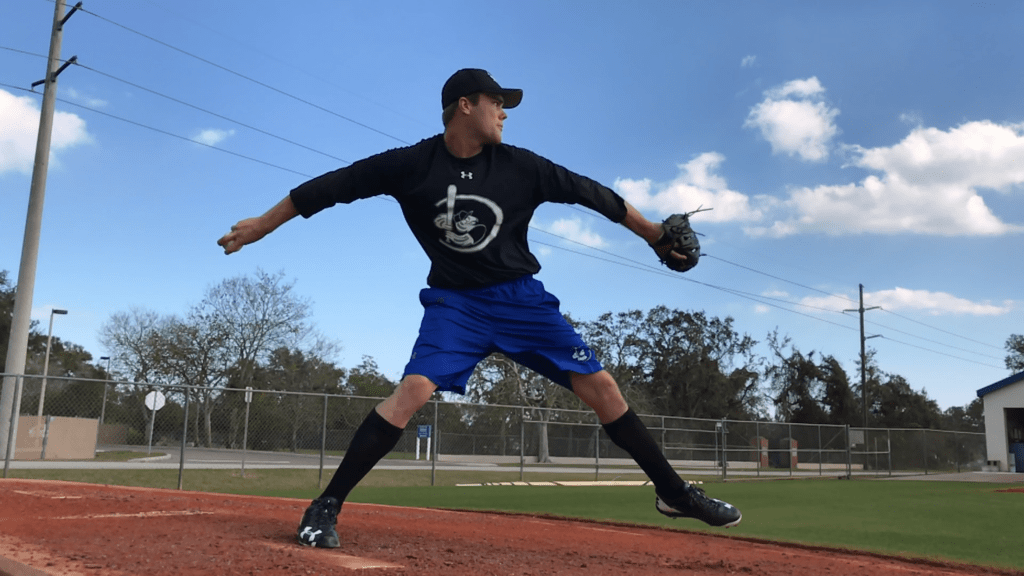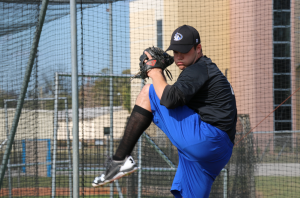What Is Tommy John Surgery? What You Should Know About UCL Reconstruction
- What Are the Symptoms of an Elbow UCL Injury?
- What Is Tommy John Surgery for UCL Injuries?
- What Is Recovery Like for UCL Surgery?
- Getting back to normal after UCL reconstruction
Landon “Gage” Hutchinson, a sophomore baseball pitcher at Daytona State College, spent his entire life dreaming of a career as a professional baseball player. Then, he suffered an all-too-common injury to a ligament in his throwing elbow and had to put the game he loves so much on hold. This is the story of his ulnar collateral ligament (or UCL) reconstruction surgery and recovery, also called Tommy John surgery for athletes.
Anxious to return to the mound, Landon sought treatment from Randy S. Schwartzberg, M.D., a board-certified sports medicine specialist and orthopaedic surgeon at Orlando Orthopaedic Center.
“Everybody said we’ve got to go to Dr. Schwartzberg,” Landon recalls. “It was a no-brainer, he’s as good as it gets.”
After meeting with Dr. Schwartzberg, it was clear that to return to top form Landon would require an ulnar collateral ligament reconstruction surgery (often referred to as a Tommy John or UCL surgery) to repair his injured throwing elbow.
“Gage had an ulnar collateral ligament tear in his elbow. This is the Tommy John injury so many pitchers fear and often results from overuse,” Dr. Schwartzberg explains. “It’s the important stabilizing structure on the medial part of the elbow in the throwing athlete.”
Major League Baseball recently conducted a survey and found between 2012 and 2013, 25% of major league pitchers and 15% of minor league pitchers had undergone the ulnar collateral ligament reconstruction surgery.
What Are the Symptoms of an Elbow UCL Injury?
After meeting with Dr. Schwartzberg, it was clear that to return to top form Landon would require an ulnar collateral ligament reconstruction surgery (often referred to as a Tommy John or UCL surgery) to repair his injured throwing elbow.
“Gage had an ulnar collateral ligament tear in his elbow. This is the Tommy John injury so many pitchers fear and often results from overuse,” Dr. Schwartzberg explains. “It’s the important stabilizing structure on the medial part of the elbow in the throwing athlete.”
Common symptoms of an elbow UCL injury in a throwing athlete include:
- Pain on the medial part of the elbow (“inside” part of the elbow) with throwing
- A feeling of looseness or instability in the elbow
- Loss of pitch velocity
- Loss of pitch control
- Swelling or bruising, which may present in the 24 hours following an acute tear
While anyone can suffer from a UCL injury due to overuse or trauma, baseball pitchers face the highest risk due to the repetitive movements associated with their position. Other sports such as gymnastics, javelin and wrestling have increased risks for UCL tears. However, it is very rare for normal daily activities to result in a Tommy John injury.
What Is Tommy John Surgery for UCL Injuries?

Tommy John Surgery for UCL injuries
If a baseball player is serious about their career, the Tommy John surgery becomes the best treatment option to get them back on the field at the high level of function they require to compete.
Essentially, the surgical approach for UCL reconstruction involves the surgeon replacing the injured ligament with a tendon from elsewhere in the body. Tendon graft options include:
- The palmaris longus tendon, which is a wrist and forearm tendon.
- The gracilis tendon, a lesser groin tendon that inserts in the front of the knee. The gracilis is larger and stronger than the palmaris longus.
In surgery, the surgeon will drill small tunnels in the humerus and ulna to accommodate the tendon graft. With his technique, this tendon is typically tripled for greater strength and stiffness. The graft is secured and tensioned utilizing suspension button-loop constructs.
What Is Recovery Like for UCL Surgery?
 Generally, patients can expect their recovery to break up into three distinct phases – all of which are best done under the guidance of an orthopaedic surgeon specializing in sports medicine.
Generally, patients can expect their recovery to break up into three distinct phases – all of which are best done under the guidance of an orthopaedic surgeon specializing in sports medicine.
Landon says, “Recovery is never easy. You have a surgery that’s intense and it’s always going to be pretty difficult. It’s a lot of long days of rehab and strengthening and things of that nature, but all in all it made me a little more grateful to be out on the field.”
Phase I – Right After Surgery
After the surgery, patients should wear a splint for at least 7 to 10 days to keep the elbow immobilized and do gentle range-of-motion exercises to strengthen the wrist, hand and shoulder. After that time, patients should wear an elbow range-of-motion brace designed to allow motion and protect the UCL graft.
Easy elbow and shoulder strengthening exercises are an important part of this phase. Eventually, patients can move to total-body conditioning exercises. Patients can expect the entirety of Phase I recovery to take about 6 weeks.
Phase II – 6 Weeks After Surgery
Approximately 6 weeks following the surgery, elbow and shoulder strengthening exercises are advanced. It’s important to know strengthening exercises should not be limited to just the elbow. The shoulder, scapula, trunk and legs are all involved in the throwing motion and need to be conditioned as well.
Throughout the next 6 months patients should avoid activities, namely throwing for extended amounts of time, that place a heavy burden on the new graft making up their UCL.
Phase III – 3 Months After Surgery
Functional specific exercises to prepare the player for throwing should begin three months following surgery. This training involves the whole body since the kinetic chain of the throwing motion begins at the feet and works its way all the way to the hands.
Phase IV – 4 Months After Surgery
The earliest that an interval throwing program (ITP) should commence is four months postoperatively. However it usually begins later than this for most players. The throwing demand that pitchers see requires that the throwing program phase takes quite a while to progress through. The premise of the ITP is to gradually progress distance, amount and intensity of throws over a period of time.
Getting Back to Normal After UCL Reconstruction Tommy John Surgery at Orlando Orthopaedic Center
The amount of time that it takes for a pitcher to return to competition varies. There are some that make it back in 8-9 months and there are some that need upwards of a year.
With the right care, approximately 85% of patients undergoing UCL reconstruction surgery are able to return to the game and perform at their previous performance levels.
“Dr. Schwartzberg did a great job explaining exactly what he did, what I was going to feel, and had every step of the way mapped out for me, ready to go,” says Landon. “It’s an unbelievable process and I couldn’t have asked for a better doctor.”


